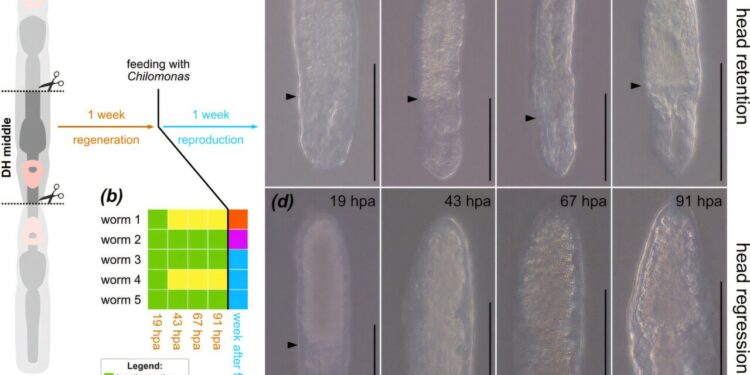Experiments on the regeneration competence of different sections of double-headed worms and the inheritance of the double-headed phenotype. Credit: Proceedings of the Royal Society B: Biological Sciences (2025). DOI: 10.1098/rspb.2025.1941
The microscopic flatworm (Stenostomum brevipharyngium) is one of nature’s strangest creatures. Cut off its head and it will grow one back. Cut it in half and it will become two separate healthy worms. And now scientists have discovered an even stranger trick. These soft-bodied, unsegmented invertebrates may have two heads, one normal and one facing backwards, in the middle of their body, where their tail should be. This developmental error allows worms to permanently reverse their body axis from head to tail without any noticeable harmful effects.
Scientists have long known how to create two-headed flatworms by applying electric currents. But this is the first time a two-headed variety has been observed occurring naturally and spontaneously. The discovery was made by accident by zoologists Katarzyna Tratkiewicz and Ludwik Gasiorowsk from the University of Warsaw in Poland during routine maintenance of their laboratory cultures. Intrigued, they decided to investigate what was happening.
The results are published in the journal Proceedings of the Royal Society B: Biological Sciences.
Flip tails in front
First, they observed their cultures under powerful microscopes and added chemical markers to confirm that the tail was missing and had been replaced by a functional head. Then they cut the two-headed worms into three pieces and tracked the healing and survival of each fragment.
The first and third sections mostly healed normally, but the middle section with the head facing backwards did something unexpected. At the opposite end of the head was an open cut, and when it healed, a second head did not grow. Instead, he regenerated a tail. This meant that the worm had succeeded and permanently reversed its head-to-tail direction.
Causes
To rule out a permanent genetic cause for the error, the researchers monitored the two-headed worms’ offspring and found that they were all normal. This proves that their axis reversal was due to developmental flexibility rather than genetic mutations.
“Our results suggest that whole-body regeneration based on pluripotent stem cells provides a flexible developmental framework in which even an inversion of the adult bilateral body AP axis can be accommodated,” the researchers wrote.
Although a genetic mutation has been ruled out, the cause of this unusual two-headed creature has not yet been determined. This could be an environmental trigger or even a random development error. It’s also unclear if this happens in the real world. Scientists have observed this in the lab, so we’ll have to wait for further research to see if this is a trick used by flatworms in the wild.
Written for you by our author Paul Arnold, edited by Gaby Clark, and fact-checked and revised by Robert Egan, this article is the result of painstaking human work. We rely on readers like you to keep independent science journalism alive. If this reporting interests you, consider making a donation (especially monthly). You will get a without advertising account as a thank you.
More information:
Katarzyna Tratkiewicz et al, Spontaneous ectopic head formation allows body axis polarity reversal in microscopic flatworms, Proceedings of the Royal Society B: Biological Sciences (2025). DOI: 10.1098/rspb.2025.1941
© 2025 Science X Network
Quote: In an accidental discovery, scientists discover that the flatworm can grow two heads and reverse the axis of its body (October 29, 2025) retrieved October 30, 2025 from
This document is subject to copyright. Except for fair use for private study or research purposes, no part may be reproduced without written permission. The content is provided for informational purposes only.



